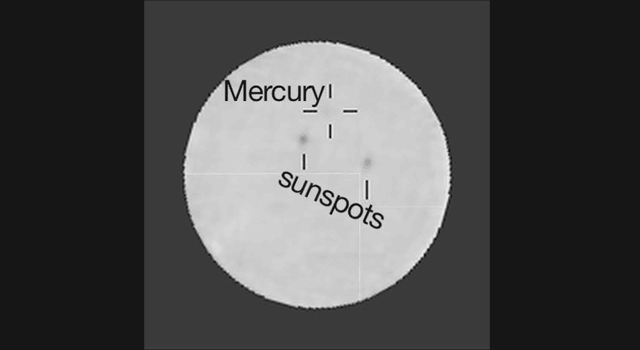 | ||
A transit of Mercury across the Sun as seen from Mars takes place when the planet Mercury passes directly between the Sun and Mars, obscuring a small part of the Sun's disc for an observer on Mars. During a transit, Mercury can be seen from Mars as a small black disc moving across the face of the Sun.
Contents
Transits of Mercury from Mars are roughly two times more common than transits of Mercury from Earth: there are several per decade.
No human has ever directly seen a transit of Mercury from Mars, but they could be observed by future Mars colonists.
Transit
The Mars rovers Spirit and Opportunity could have observed the transit of January 12, 2005 (from 14:45 UTC to 23:05 UTC); however the only camera available for this had insufficient resolution. They were able to observe transits of Deimos across the Sun, but at 2' angular diameter, Deimos is about 20 times larger than Mercury's 6.1" angular diameter. Ephemeris data generated by JPL Horizons indicates that Opportunity would have been able to observe the transit from the start until local sunset at about 19:23 UTC, while Spirit could have observed it from local sunrise at about 19:38 UTC until the end of the transit. The rover Curiosity observed the Mercury transit of June 3, 2014, marking the first time any planetary transit has been observed from a celestial body besides Earth.
The Mercury-Mars synodic period is 100.888 days. It can be calculated using the formula 1/(1/P-1/Q), where P is the orbital period of Mercury (87.969 days) and Q is the orbital period of Mars (686.98 days).
The inclination of Mercury's orbit with respect to that of Mars is 5.16°, which is less than its value of 7.00° with respect to Earth's ecliptic.
Simultaneous transits
The simultaneous occurrence of a transit of Mercury and a transit of Venus is extremely rare, but somehow more frequent than from Earth, and will next occur in the years 18,713, 19,536 and 20,029.
On several occasions a related event is predicted: a transit of Mercury and a transit of Venus, or transit of Earth, will follow themselves, one after the other, in an interval of only several hours.
On November 28, 3867 there is a transit of Earth and Moon, and two days later a transit of Mercury occurs. On January 16, 18551 transits of Mercury and Venus are separated by 14 hours.
